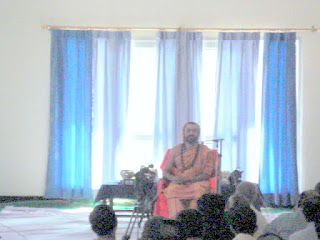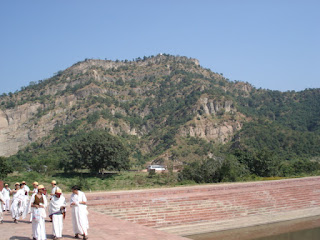Om Shri Ganseha pic courtesy: Komal Nadkarni
Centres Of Pilgrimages Are Sacred Spaces6 Nov 2007, 0050 hrs IST,Ashok Vohra
Tirtha or pilgrimage occupies a central place in the rituals and practices of the faithfuls. The word tirtha is derived from the root tri, which means ‘to cross over' - that is, to go up or to go down. The word avatar is also derived from the same root; it means ‘to descend', ‘to come down'. A tirtha is a place on earth where the gods descend and which facilitates the crossing over, enabling ascent of human beings from bhavasagar --or the temporal and ephemeral world of naama and rupa, name and form, multiplicity and diversity, to the eternal abode of oneness, peace, tranquillity and bliss. Tirtha really stood for knowledge as knowledge alone helps us get over ignorance and leads to liberation. It has now come to mean a sacred place which helps one to cross over from the cycle of birth and death to moksha or liberation. The Mahabharata says: “Just as certain parts of the body are called pure, so are certain parts of the earth and certain waters called holy”. These parts of the earth are called tirthas. A tirtha is a ford, a crossing and a passageway by visiting which one could be freed of all sin. The metaphor of a ford or a bridge acts as a linking function, which among other things, brings together and links ideas, concepts, points of view and practices that are different. The bridge is not a stable habitat, you are not expected to stay or stand on it for long periods. It is on the way from somewhere to somewhere, a transition. It connects the past with the present and future. According to Tristhalisetu, a tirtha is a place where “whatever is sacrificed, chanted, given in charity, or suffered in penance, even in the smallest amount, yields endless fruit because of the power of that place... Whatever fruit is said to accrue from many thousands of lifetimes of asceticism, even more than that is obtainable from but three nights of fasting in this place”. The Shiva Purana states that “the punyas earned in a tirtha destroy all sins - physical, mental and those committed through speech. NOTE: At the same time evil actions done in a tirtha yield evil results of which one is not easily absolved”. It also warns not to indulge in immoral deeds in a tirtha because the evil results of an immoral action performed in a tirtha are multiplied manifold. It, therefore, advises that one should be extremely cautious about one's actions in the punyakshetra, the sacred region of a tirtha. Tirthas have the power to cleanse the soul of its acquired sins. A tirtha is not only mokshada or bestower of liberation; it is also sukhda or bestower of happiness. It provides for both mukti or liberation and bhukti or enjoyment. The various tirthas in India are spread out geographically, forming a mahaparikrama or mahapradakshina, the great circumambulation of the entire country. Tirthas, therefore, yield not just spiritual gains; they help individuals familiarise themselves with the geographical vastness, cultural diversity and unity of the country. That probably was the aim of Indian sages in attaching a spiritual significance to each of the tirthas and persuading the populace to go around all of them to attain moksha. NOTE:That is why Mark Twain has rightly observed that the tirthas are “older than history, older than tradition, older even than legend”. byAshok VohraThe writer is professor of philosophy, Delhi University.
Courtesy : Rajkumar Trikannad maam
THE SPEAKING TREE: River Mythologies Tell A Different Story
23rd March 2007 ,V Rajaraman
With most of the world's rivers under threat from pollution and global warming, it would be instructive to revisit our traditional perceptions of rivers as life-givers and sustainers. Spiritual tradition enjoins us to remember in our daily prayers the sacred rivers Ganga, Yamuna, Godavari, Saraswati, Narmada, Sindhu and Cauvery as a thanksgiving to Mother Nature. In ancient times people held rivers in awe and endowed them with mystical origins. The turbulent Ganga was brought down to earth by Lord Shiva and to humble the pride of Ganga knotted her in his matted locks. The Cauvery began its flow from a 'kamandala' that sage Agastya kept by his side while meditating. Vinayaka, taking the form of a crow, tilted the vessel and the water that spilt from the vessel became the wide and sprawling river. This is one among the many Puranic versions of the origin of the Cauvery. The Cauvery since that timeless mythical day has been flowing through the plains braving the vicissitudes of history. In the process, under the patronage of administrators from the ancient Chola dynasty to recent times, the river has engendered glorious traditions of art, music and literature. The cultural heritage which Thanjavur and Mysore have inherited could rival that of any other in the world. The trinity of Carnatic music, Thyagaraja, Shyama Sastri and Muthuswami Dikshitar, belong to the Thanjavur-Cauvery delta. The mighty temples that dot the banks of the river, many of them masterpieces of architecture, still bear eloquent testimony to what the Cauvery did, not only in fertilising the soil but in nurturing the mind and soul of man.
The tradition continues even today though mutilated by opportunistic interpretations of modernity. The Cauvery watches it all with sagely dispassion from Coorg where she originates in the cool and dense shades of the green mountains and flows into the eastern coast where she meets the blue waters of the Bay of Bengal.
Karnataka and Tamil Nadu are at loggerheads over the sharing of the waters of the Cauvery. "Politics is too much with us", as poet William Wordsworth once bemoaned. A little philosophical reflection is necessary to subdue frayed tempers and nerves. Do we belong to a river or does the river belong to us?
I wonder if there would have ever been the glorious Egyptian civilisation if the waters of the Lake Tana in Ethiopia and those of Lake Victoria, much south of Egypt, had been stopped from flowing their respective courses into the Nile Valley of Egypt. And what if China stopped the mighty Brahmaputra flow through the gorges of the Himalayas into the plains of north-eastern India? 'Never ask the origin of a sage or the source of a river' is a familiar adage in India. Rivers are known to rise as though from nowhere, change their course unpredictably or just go into subterranean oblivion like the mythical river Saraswati which continues to baffle geological speculation. To arrogate claim over a river or its waters is to ignore its unpredictability, its vagaries, its potency for destruction as much as our failure to understand its blessings. At the substratum, a philosophical recognition or, still better, a perception of the river is necessary to understand how best to harness its waters; in short how best to use its waters for the benefit of all, for the common good.
Courtesy : Rajkumar Trikannad maam







 Multifaceted display:
Multifaceted display:



 The river bed site:
The river bed site:

































